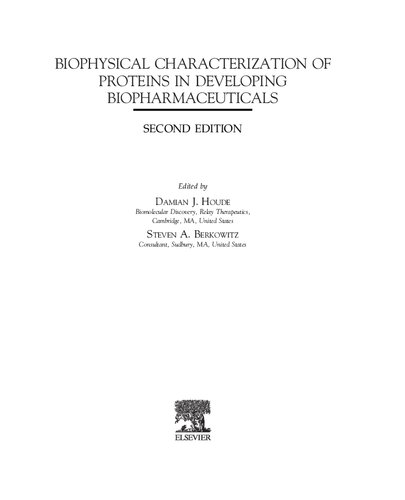Biophysical Characterization of Proteins in Developing Biopharmaceuticals 2nd Edition by Damian Houde, Steven Berkowitz 0444641734 9780444641731
$50.00 Original price was: $50.00.$25.00Current price is: $25.00.
Biophysical Characterization of Proteins in Developing Biopharmaceuticals 2nd Edition by Damian Houde, Steven Berkowitz – Ebook PDF Instant Download/Delivery: 0444641734, 9780444641731
Full download Biophysical Characterization of Proteins in Developing Biopharmaceuticals 2nd Edition after payment

Product details:
ISBN 10: 0444641734
ISBN 13: 9780444641731
Author: Damian J. Houde, Steven A. Berkowitz
Biophysical Characterization of Proteins in Developing Biopharmaceuticals, Second Edition, presents the latest on the analysis and characterization of the higher-order structure (HOS) or conformation of protein based drugs. Starting from the very basics of protein structure, this book explains the best way to achieve this goal using key methods commonly employed in the biopharmaceutical industry. This book will help today’s industrial scientists plan a career in this industry and successfully implement these biophysical methodologies. This updated edition has been fully revised, with new chapters focusing on the use of chromatography and electrophoresis and the biophysical characterization of very large biopharmaceuticals.
In addition, best practices of applying statistical analysis to biophysical characterization data is included, along with practical issues associated with the concept of a biopharmaceutical’s developability and the technical decision-making process needed when dealing with biophysical characterization data.
- Presents basic protein characterization methods and tools applicable to (bio)pharmaceutical research and development
- Highlights the capabilities and limitations of each technique
- Discusses the underlining science of each tool
- Empowers industrial biophysical chemists by providing a roadmap for applying biophysical tools
- Outlines the needs for new characterization and analytical tools in the biopharmaceutical industry
Biophysical Characterization of Proteins in Developing Biopharmaceuticals 2nd Table of contents:
I. Proteins and biophysical characterization in the biopharmaceutical industry
Chapter 1. The complexity of protein structure and the challenges it poses in developing biopharmaceuticals
1.1. The basics of protein higher order structure (HOS)
1.2. The search for how proteins attain their correct HOS: the protein folding problem
1.3. Surprises in the world of protein folding: intrinsically disordered or unstructured proteins (an apparent challenge to the protein Structure–Function paradigm)
1.4. Proteins and the biopharmaceutical industry: problems and challenges
1.5. Conclusion
Chapter 2. Biophysical characterization and its role in the biopharmaceutical industry
2.1. Drug development process
2.2. Protein drugs (biopharmaceuticals)
2.3. The role of biophysical characterization in biopharmaceutical drug development
2.4. The challenges in conducting biophysical measurements to detect changes in a protein drug’s HOS
2.5. Regulatory needs and considerations
Chapter 3. Biopharmaceutical industry’s biophysical toolbox
3.1. Attributes of a single biophysical tool to characterize and detect changes in the higher order structure of a biopharmaceutical
3.2. Studying the biophysical properties of a biopharmaceutical as an indirect approach for characterizing changes in its HOS
3.3. General considerations in analyzing the biophysical properties of biopharmaceuticals
3.4. The utility of using stress to monitor changes in the HOS profile of a protein drug
3.5. Present biophysical toolbox
3.6. Conclusion
II. The selected biophysical tools in the biopharmaceutical industry
Chapter 4. An introduction and hierarchical organization of the biophysical tool in section II
4.1. Introduction
4.2. The standard class of biophysical tools used in the biopharmaceutical industry
4.3. The advanced class of biophysical tools used in the biopharmaceutical industry
4.4. An overview of section II
Chapter 5. UV-absorbance, fluorescence and FT-IR spectroscopy in biopharmaceutical development
5.1. Introduction
5.2. The origins of electronic absorption, fluorescence, and FT-IR spectroscopy
5.3. Conformational analysis of proteins in solution
5.4. Optical and vibrational spectroscopy and product comparability
5.5. Optical and vibrational spectroscopy and high throughput methods
5.6. Solid-state measurements
5.7. Conclusions
Chapter 6. Biopharmaceutical applications of protein characterisation by circular dichroism spectroscopy
6.1. Introduction
6.2. Instrumentation
6.3. Data generated
6.4. Guide to collecting good data
6.5. Data processing and analyses
6.6. Role in the research industry
6.7. Technology availability
6.8. Future developments
Chapter 7. Size-exclusion chromatography (SEC) in biopharmaceutical process development
7.1. Introduction
7.2. Basic theory of normal or ideal SEC
7.3. Maximizing SEC separation by enhancing the usage of pore volume and pore structure
7.4. Characteristics of pore structure
7.5. Nonideal SEC chromatography
7.6. Assessing and maintaining an optimum SEC chromatography method
7.7. Detectors
7.8. Multidetector SEC
7.9. Aggregation
7.10. Technology advances
7.11. Conclusion
Chapter 8. Scattering techniques for the characterization of biopharmaceuticals
8.1. Introduction
8.2. Intensity- and time-dependent light scattering
8.3. General comment concerning SLS and DLS
8.4. The “dust problem” in SLS and DLS
8.5. X-ray scattering: characterization of proteins in solution using small-angle X-ray scattering
Chapter 9. Characterizing biopharmaceuticals using analytical ultracentrifugation
9.1. Introduction
9.2. Unique features of the analytical ultracentrifuge that make it different from other centrifuges
9.3. Theory
9.4. Utility of AUC in the biopharmaceutical industry
9.5. Boundary SV-AUC
9.6. Expanding the dynamic size range that can be characterized in a single SV-AUC run
9.7. Band SV-AUC
9.8. Sedimentation equilibrium, SE-AUC
9.9. Density-gradient SE-AUC
9.10. AUC detectors
9.11. Miscellaneous helpful information about conducting AUC experiments
9.12. The introduction of the next (third) generation analytical ultracentrifuge (Optima) by Beckman Coulter
9.13. Conclusions
Chapter 10. Submicrometer, micrometer and visible particle analysis in biopharmaceutical research and development
10.1. Introduction
10.2. Overview of analytical methods
10.3. General recommendations and pitfalls for particle analysis
10.4. Outlook and conclusions
Chapter 11. Differential scanning calorimetry in the biopharmaceutical sciences
11.1. Background
11.2. DSC instruments
11.3. Practical considerations for DSC use
11.4. Data analysis
11.5. Applications of solution DSC in biopharmaceutical Discovery and Development
11.6. Applications of solid-sample DSC in biopharmaceutical discovery and development
11.7. Conclusions
Chapter 12. Biophysical mass spectrometry for biopharmaceutical process development: focus on hydrogen/deuterium exchange
12.1. Introduction
12.2. Synopsis of the technique
12.3. Mechanism of exchange
12.4. Advances in the technique
12.5. Commercialization
12.6. Applications in the biopharmaceutical industry
12.7. Future perspective
Chapter 13. One- and two-dimensional NMR techniques
13.1. Introduction
13.2. Physical basis of the technique
13.3. The appropriate technique for a particular problem
13.4. Method requirements and performance
13.5. Data processing (procedures)
13.6. Role in research versus process development
13.7. Technology update: recent and future advances and unique applications
Chapter 14. Chromatography (other than size-exclusion chromatography) and electrophoresis
14.1. Introduction
14.2. Common features of concern when using chromatography and electrophoresis as biophysical characterization tools
14.3. Chromatography
14.4. Electrophoresis
14.5. Some novel methods where chromatography or electrophoresis was used to help biophysical characterize protein biopharmaceuticals
14.6. Characterizing the chromatographic and electrophoretic separations
14.7. The challenge that come with the ever-increasing higher resolution chromatography and electrophoresis when characterizing protein biopharmaceuticals
14.8. Summary
III. Concluding remarks on the biophysical characterization of biopharmaceuticals
Chapter 15. Challenges with the biophysical characterization of complex (multi-chain assembly, chemically modified, big and high concentration) biopharmaceuticals
15.1. Introduction
15.2. Complex biopharmaceuticals I: multi-polypeptide chain protein in vivo assembly
15.3. Complex biopharmaceuticals III: novel multi-polypeptide chain protein assembly in vivo to form bispecific antibodies
15.4. Complex biopharmaceuticals IV: via in vitro chemical modifications or in vivo recombinant coupling
15.5. Complex biopharmaceuticals V: assembly of large multi-protein biopharmaceutical structures – viral vectors (in gene therapy)
15.6. Complex biopharmaceuticals VI: high concentration biopharmaceuticals (mAbs)
15.7. Summary
Chapter 16. The rigor of statistical analysis in assessing biophysical data: A lifecycle approach
16.1. Introduction
16.2. Description of the lifecycle approach
16.3. Characteristics of biophysical procedures
16.4. Statistical approaches in stage 1 of the lifecycle approach
16.5. Statistical approaches in stage 2 of the lifecycle approach
16.6. Statistical assessment in stage 3 of the lifecycle approach
16.7. Considerations for successful implementation of a lifecycle approach: management of biophysical procedures
16.8. Summary
Chapter 17. Developability in biophysical characterization
17.1. Introduction
17.2. Computational structural methods and their use in lead candidate selection and in engineering
17.3. Formulation considerations for developability screening
17.4. Critical quality attribute based testing in developability
17.5. Colloidal stability: predicting protein solution behavior
17.6. Viscosity and various mature and emerging viscosity technologies
17.7. Conformational stability
17.8. Conclusion and future of aspects of developability
Chapter 18. Technical decision making using biophysical data
18.1. Introduction
18.2. Current perspectives and recent trends
18.3. Future direction
18.4. Conclusion
Chapter 19. Biophysical characterization: an integral part of the “totality of the evidence” concept
19.1. Biopharmaceutical development
19.2. An introduction to the “totality of the evidence” and its more global meaning in developing biopharmaceuticals
19.3. Biophysical characterization in developing protein biopharmaceuticals
19.4. Building a Biopharmaceutical’s biophysical fingerprint
19.5. Detecting small differences in biopharmaceuticals via biophysical characterization measurements
19.6. Conclusion
People also search for Biophysical Characterization of Proteins in Developing Biopharmaceuticals 2nd:
biophysical characterization of high confidence small human proteins
protein biophysical characterization
what does a biophysical profile measure
j proteins
Tags:
Damian Houde,Steven Berkowitz,Biophysical,Characterization
You may also like…
Chemistry - Biochemistry
Biophysical Chemistry by P.S. Kalsi; N. Mahanta 1781830037 9781781830031
Jurisprudence & Law - Medical Law
The Challenge of CMC Regulatory Compliance for Biopharmaceuticals, 4th John Geigert
Engineering - Industrial Engineering & Materials Science
Obtaining and Characterization of New Materials Volume III 2nd Edition Andrei Victor Sandu
Biology and other natural sciences
Characterization of Bioactive Components in Edible Algae by Leonel Pereira Editor
Uncategorized
Uncategorized
Changing Law in Developing Countries 1st Edition by JND Anderson ISBN 9781032157788 103215778X
Uncategorized
Uncategorized










